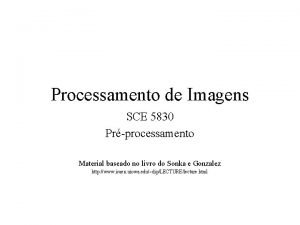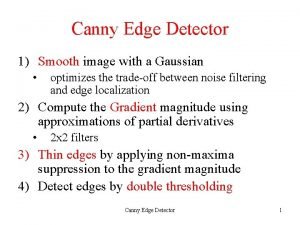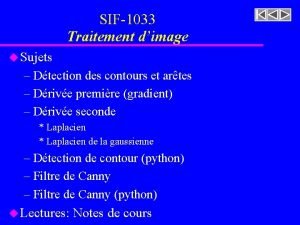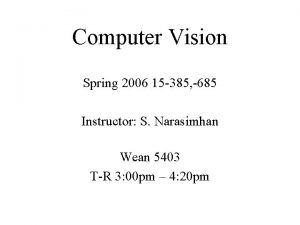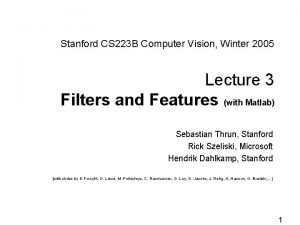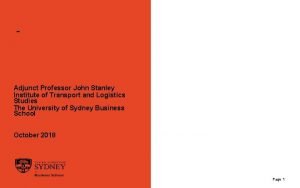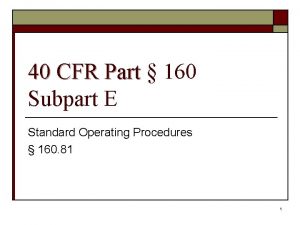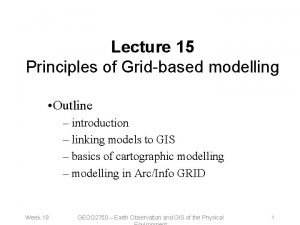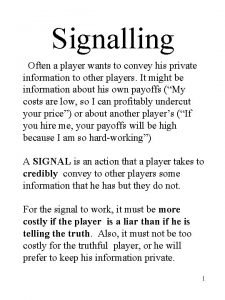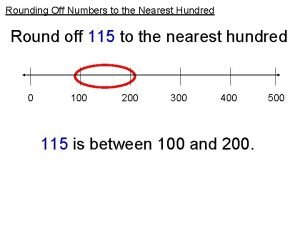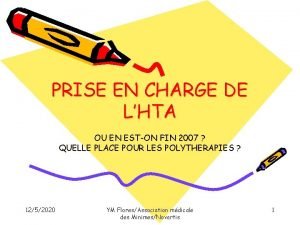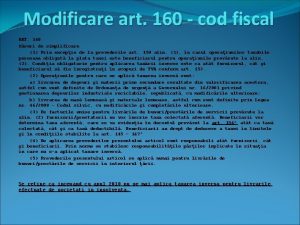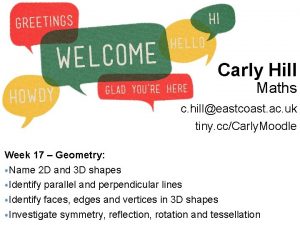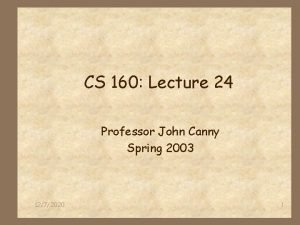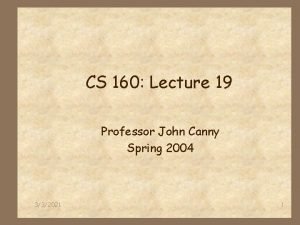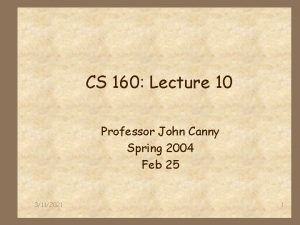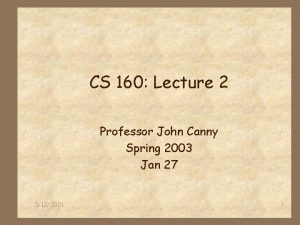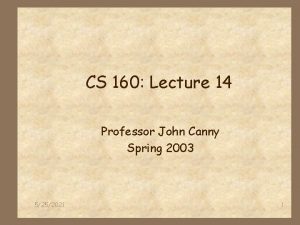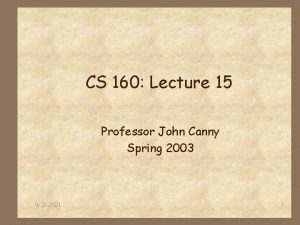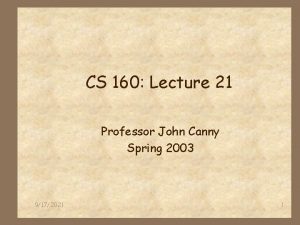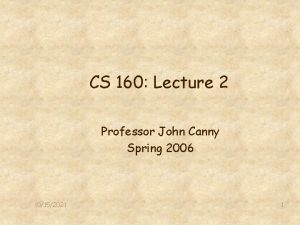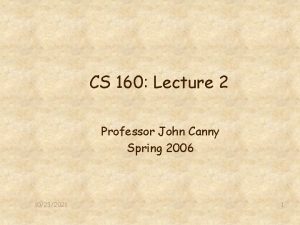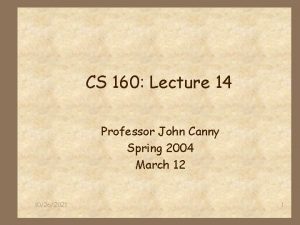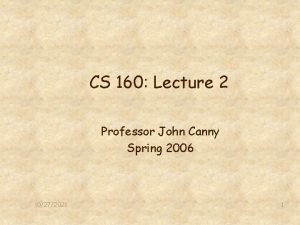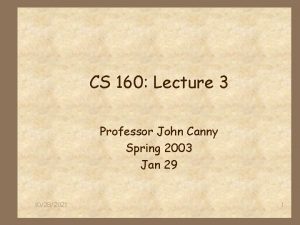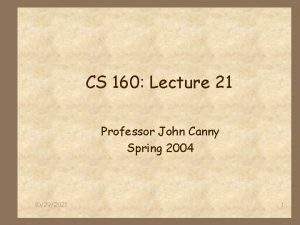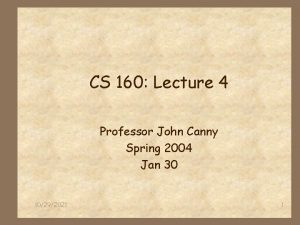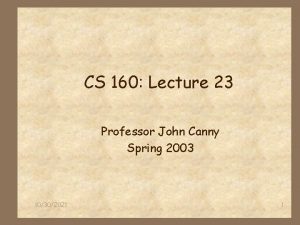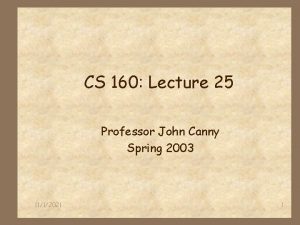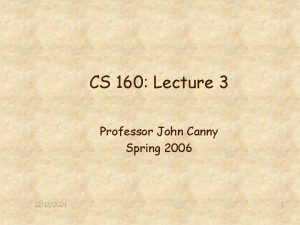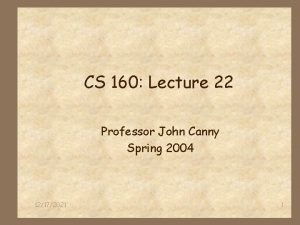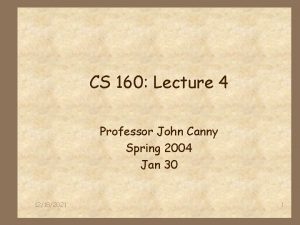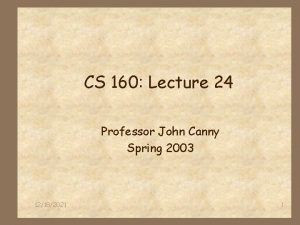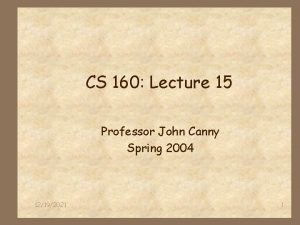CS 160 Lecture 7 Professor John Canny Spring







































![Severity Ratings Example 1. [H 1 -4 Consistency] [Severity 3][Fix 0] The interface used Severity Ratings Example 1. [H 1 -4 Consistency] [Severity 3][Fix 0] The interface used](https://slidetodoc.com/presentation_image/34c8d2f0e2a18be0801c9c324de72934/image-40.jpg)

![Results of Using HE 4 Discount: benefit-cost ratio of 48 [Nielsen 94] * Cost Results of Using HE 4 Discount: benefit-cost ratio of 48 [Nielsen 94] * Cost](https://slidetodoc.com/presentation_image/34c8d2f0e2a18be0801c9c324de72934/image-42.jpg)



- Slides: 45

CS 160: Lecture 7 Professor John Canny Spring 2004 Feb 13 9/16/2020 1

Outline 4 User testing for Lo-Fi prototype 4 Discount usability engineering 4 Heuristic evaluation overview 4 Heuristics 4 How to perform a HE 4 HE vs. user testing 4 How well does HE work 9/16/2020 2

Iterative Design task analysis contextual inquiry scenarios sketching Prototype low-fi paper, DENIM Evaluate 9/16/2020 low-fi testing, Heuristic eval 3

Preparing for a User Test 4 Objective: narrow or broad? 4 Design the tasks 4 Decide on whether to use video 4 Choose the setting 4 Representative users 9/16/2020 4

10 steps 1. Introduce yourself 2. Describe the purpose of the observation (in general terms), and set the participant at ease * You're helping us by trying out this product in its early stages. * If you have trouble with some of the tasks, it's the product's fault, not yours. Don't feel bad; that's exactly what we're looking for. 9/16/2020 5

10 steps (contd. ) 3. Tell the participant that it's okay to quit at any time, e. g. : * Although I don't know of any reason for this to happen, if you should become uncomfortable or find this test objectionable in any way, you are free to quit at any time. 4. Talk about the equipment in the room. * Explain the purpose of each piece of equipment (hardware, software, video camera, microphones, etc. ) and how it is used in the test. 9/16/2020 6

10 steps (contd. ) 5. Explain how to “think aloud. ” * Explain why you want participants to think aloud, and demonstrate how to do it. E. g. : * We have found that we get a great deal of information from these informal tests if we ask people to think aloud as they work through the exercise. Would you like me to demonstrate? 6. Explain that you cannot provide help. * Say that it is not important to complete all tasks perfectly – you are not grading the subject’s performance. 9/16/2020 7

10 steps (contd. ) 7. Describe the tasks and introduce the product. * Explain what the participant should do and in what order. Give the participant written instructions for the tasks. * Don’t demonstrate what you’re trying to test. 8. Ask if there any questions before you start; then begin the observation. 9/16/2020 8

10 steps (contd. ) 9. Conclude the observation. When the test is over: * Explain what you were trying to find. * Answer any remaining questions. * discuss any interesting behaviors you would like the participant to explain. 10. Use the results. * When you see participants making mistakes, you should attribute the difficulties to faulty product design, not to the participant. 9/16/2020 9

Using the Results 4 Update task analysis and rethink design * Rate severity & ease of fixing critical incidents * Fix both severe problems & make the easy fixes 4 Will thinking aloud give the right answers? * Not always * If you ask a question, people will always give an answer, even it is has nothing to do with the facts * Try to avoid leading questions 9/16/2020 10

Severity Rating 4 Used to allocate resources to fix problems 4 Estimate of consequences of that bug 4 Combination of * Frequency * Impact * Persistence (one time or repeating) 4 Should be calculated after all evaluations are in 4 Should be done independently by all judges 9/16/2020 11

Severity Ratings (cont. ) 0 - don’t agree that this is a usability problem 1 - cosmetic problem 2 - minor usability problem 3 - major usability problem; important to fix 4 - usability catastrophe; imperative to fix 9/16/2020 12

Debriefing 4 Conduct with evaluators, observers, and development team members. 4 Discuss general characteristics of UI. 4 Suggest potential improvements to address major usability problems. 4 Development team rates how hard things are to fix. 4 Make it a brainstorming session * little criticism until end of session 9/16/2020 13

Low-fi assignment 4 Your evaluation will use the techniques just described: User testing and severity ratings. 4 Next topic (future assignment): discount usability methods and heuristic evaluation. 9/16/2020 14

Break Laptop info: 4 Laptops will be available from next Weds. 4 There is no fee, but we need a refundable deposit of $200. 4 Deposits should be by check made out to “UC Regents”. 4 Checks will be held by the instructional group and returned when the laptop is returned, unless damaged. 9/16/2020 15

Discount Usability Engineering 4 Cheap * no special labs or equipment needed * the more careful you are, the better it gets 4 Fast * on order of 1 day to apply * standard usability testing may take a week 4 Easy to use * can be taught in 2 -4 hours 9/16/2020 16

Discount Usability Engineering 4 Based on: * Scenarios * Simplified thinking aloud * Heuristic Evaluation 9/16/2020 17

Scenarios 4 Eliminate parts of the system 4 Compromise between horizontal and vertical prototypes 9/16/2020 18

Simplified thinking aloud 4 Bring in users 4 Give them real tasks on the system 4 Ask them to think aloud 4 No video-taping – rely on notes 9/16/2020 19

Other budget methods 4 Walkthroughs * Put yourself in the shoes of a user * Like a code walkthrough 4 Low-fi prototyping 4 Action analysis * GOMS (add times to formal action analysis) 4 On-line, remote usability tests 4 Heuristic evaluation 9/16/2020 20

Heuristic Evaluation 4 Developed by Jakob Nielsen 4 Helps find usability problems in a UI design 4 Small set (3 -5) of evaluators examine UI * Independently check for compliance with usability principles (“heuristics”) * Different evaluators will find different problems * Evaluators only communicate afterwards + Findings are then aggregated 4 Can perform on working UI or on sketches 9/16/2020 21

Why Multiple Evaluators? 4 Every evaluator doesn’t find every problem 4 Good evaluators find both easy & hard ones 9/16/2020 22

Heuristic Evaluation Process 4 Evaluators go through UI several times * Inspect various dialogue elements * Compare with list of usability principles * Consider other principles/results that come to mind 4 Usability principles * Nielsen’s “heuristics” * Supplementary list of category-specific heuristics + competitive analysis & user testing of existing products 4 Use violations to redesign/fix problems 9/16/2020 23

Heuristics (original) 4 H 1 -1: Simple & natural 4 H 1 -6: Clearly marked 4 4 4 dialog H 1 -2: Speak the users’ language H 1 -3: Minimize users’ memory load H 1 -4: Consistency H 1 -5: Feedback 9/16/2020 4 4 4 exits H 1 -7: Shortcuts H 1 -8: Precise & constructive error messages H 1 -9: Prevent errors H 1 -10: Help and documentation 24

Revised Heuristics 4 Based on factor analysis of 249 usability problems 4 A prioritized, independent set of heuristics 9/16/2020 25

Revised Heuristics 4 H 2 -1: visibility of 4 4 4 H 2 -6: Recognition rather than recall system status 4 H 2 -7: Flexibility and H 2 -2: Match system efficiency of use and real world H 2 -3: User control and 4 H 2 -8: Aesthetic and minimalist design freedom H 2 -4: Consistency and 4 H 2 -9: Help users recognize, diagnose and standards recover from errors H 2 -5: Error prevention 4 H 2 -10: Help and documentation 9/16/2020 26

Heuristics (revised set) searching database for matches 4 H 2 -1: Visibility of system status * keep users informed about what is going on * example: pay attention to response time + 0. 1 sec: no special indicators needed, why? + 1. 0 sec: user tends to lose track of data + 10 sec: max. duration if user to stay focused on action + for longer delays, use percent-done progress bars 9/16/2020 27

Heuristics (cont. ) 4 H 2 -2: Match between system & real world * speak the users’ language * follow real world conventions 4 Bad example: Mac desktop * Dragging disk to trash * should delete it, not eject it 9/16/2020 28

Heuristics (cont. ) 4 Wizards * For infrequent tasks 4 H 2 -3: User control & freedom * “exits” for mistaken choices, undo, redo * don’t force down fixed paths like BART ticket machine… 9/16/2020 (e. g. , modem config. ) * Not for common tasks * Good for beginners * have 2 versions (Win. Zip) 29

Heuristics (cont. ) 4 H 2 -4: Consistency & standards 9/16/2020 30

Heuristics (cont. ) 4 H 2 -5: Error prevention 4 MS Web Pub. Wiz. 4 H 2 -6: Recognition rather than recall 4 Before dialing, asks for id & password options, & directions visible 4 When connecting, asks or easily retrievable again for id & pw 4 make objects, actions, 9/16/2020 31

Heuristics (cont. ) Edit Cut Copy Paste 4 H 2 -7: Flexibility and efficiency of use * accelerators for experts (e. g. , gestures, keyboard shortcuts) * allow users to tailor frequent actions (e. g. , macros) 9/16/2020 32

Heuristics (cont. ) 4 H 2 -8: Aesthetic and minimalist design * no irrelevant information in dialogues 9/16/2020 33

Heuristics (cont. ) 4 H 2 -9: Help users recognize, diagnose, and recover from errors * Error messages in plain language * Precisely indicate the problem * Constructively suggest a solution 9/16/2020 34

Heuristics (cont. ) 4 H 2 -10: Help and documentation * * Easy to search Focused on the user’s task List concrete steps to carry out Not too large 9/16/2020 35

Phases of Heuristic Evaluation 1) Pre-evaluation training * Give evaluators needed domain knowledge and information on the scenario 2) Evaluation * Individuals evaluate and then aggregate results 3) Severity rating * Determine how severe each problem is (priority) * Can do this first individually and then as a group 4) Debriefing * Discuss the outcome with design team 9/16/2020 36

How to Perform Evaluation 4 At least two passes for each evaluator * First to get feel for flow and scope of system * Second to focus on specific elements 4 If system is walk-up-and-use or evaluators are domain experts, no assistance needed * Otherwise might supply evaluators with scenarios 4 Each evaluator produces list of problems * Explain why with reference to heuristic or other information * Be specific and list each problem separately 9/16/2020 37

Examples 4 Can’t copy info from one window to another * Violates “Minimize users’ memory load” (H 1 -3) * Fix: allow copying 4 Typography uses mix of upper/lower case formats and fonts * * Violates “Consistency and standards” (H 2 -4) Slows users down Probably wouldn’t be found by user testing Fix: pick a single format for entire interface 9/16/2020 38

How to Perform Evaluation 4 Why separate listings for each violation? * Risk of repeating problematic aspect * May not be possible to fix all problems 4 Where problems may be found * Single location in UI * Two or more locations that need to be compared * Problem with overall structure of UI * Something that is missing - hard w/ paper prototypes so work extra hard on those * Note: sometimes features are implied by design docs and just haven’t been “implemented” – relax on those 9/16/2020 39
![Severity Ratings Example 1 H 1 4 Consistency Severity 3Fix 0 The interface used Severity Ratings Example 1. [H 1 -4 Consistency] [Severity 3][Fix 0] The interface used](https://slidetodoc.com/presentation_image/34c8d2f0e2a18be0801c9c324de72934/image-40.jpg)
Severity Ratings Example 1. [H 1 -4 Consistency] [Severity 3][Fix 0] The interface used the string "Save" on the first screen for saving the user's file, but used the string "Write file" on the second screen. Users may be confused by this different terminology for the same function. 9/16/2020 40

HE vs. User Testing 4 HE is much faster * 1 -2 hours each evaluator vs. days-weeks 4 HE doesn’t require interpreting user’s actions 4 User testing is far more accurate (by def. ) * Takes into account actual users and tasks * HE may miss problems & find “false positives” 4 Good to alternate between HE & user testing * Find different problems * Don’t waste participants 9/16/2020 41
![Results of Using HE 4 Discount benefitcost ratio of 48 Nielsen 94 Cost Results of Using HE 4 Discount: benefit-cost ratio of 48 [Nielsen 94] * Cost](https://slidetodoc.com/presentation_image/34c8d2f0e2a18be0801c9c324de72934/image-42.jpg)
Results of Using HE 4 Discount: benefit-cost ratio of 48 [Nielsen 94] * Cost was $10, 500 for benefit of $500, 000 * Value of each problem ~15 K (Nielsen & Landauer) * How might we calculate this value? + in-house -> productivity; open market -> sales 4 Correlation between severity & finding w/ HE 9/16/2020 42

Results of Using HE (cont. ) 4 Single evaluator achieves poor results * Only finds 35% of usability problems * 5 evaluators find ~ 75% of usability problems * Why not more evaluators? ? 10? 20? + adding evaluators costs more + many evaluators won’t find many more problems * But always depends on market for product: popular products -> high support costs for small bugs 9/16/2020 43

Decreasing Returns problems found benefits / cost 4 Caveat: graphs for a specific example 9/16/2020 44

Summary 4 Heuristic evaluation is a discount method 4 Have evaluators go through the UI twice 4 Ask them to see if it complies with heuristics * note where it doesn’t and say why 4 Combine the findings from 3 to 5 evaluators 4 Have evaluators independently rate severity 4 Discuss problems with design team 4 Alternate with user testing 9/16/2020 45
 Imagem de uma rampa fonte max pixel
Imagem de uma rampa fonte max pixel What is canny edge detection in image processing
What is canny edge detection in image processing Filtre laplacien
Filtre laplacien Canny
Canny Joe canny
Joe canny Canny
Canny Canny
Canny Canny sebastian
Canny sebastian Edge detection
Edge detection Promotion from associate professor to professor
Promotion from associate professor to professor A college professor never finishes his lecture
A college professor never finishes his lecture What is this
What is this 01:640:244 lecture notes - lecture 15: plat, idah, farad
01:640:244 lecture notes - lecture 15: plat, idah, farad Spring, summer, fall, winter... and spring cast
Spring, summer, fall, winter... and spring cast Spring summer autumn winter dates
Spring summer autumn winter dates Professor john forsythe
Professor john forsythe Professor john forsythe
Professor john forsythe Professor john wood
Professor john wood Holland self directed search
Holland self directed search Professor john hattie
Professor john hattie Professor john hughes
Professor john hughes John stanley temple
John stanley temple 80 in 20 eksiği kaçtır
80 in 20 eksiği kaçtır Smt 160-30
Smt 160-30 12vac35-105-620
12vac35-105-620 Wac 296-800-160
Wac 296-800-160 Anticorps anti-nucléaire positif moucheté
Anticorps anti-nucléaire positif moucheté Konica minolta bizhub 160
Konica minolta bizhub 160 Parafrasi il canto delle sirene
Parafrasi il canto delle sirene Dd620
Dd620 40 cfr 160
40 cfr 160 Carolina windom antenna
Carolina windom antenna 160 fifth avenue nyc
160 fifth avenue nyc What does similar triangles mean
What does similar triangles mean El doble del exceso de un numero aumentado en 5
El doble del exceso de un numero aumentado en 5 6280/160
6280/160 Capr 160-1
Capr 160-1 Bentuk perkalian dari cos 2a – cos 4a = ....
Bentuk perkalian dari cos 2a – cos 4a = .... Psalm 119:160
Psalm 119:160 160/60
160/60 663 rounded to the nearest hundred
663 rounded to the nearest hundred Cbe 160
Cbe 160 Exforge 160/10 prix maroc
Exforge 160/10 prix maroc 1600000/160
1600000/160 Art 160 cod fiscal
Art 160 cod fiscal 160/60
160/60
